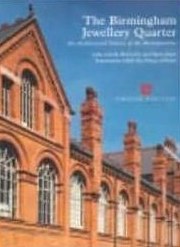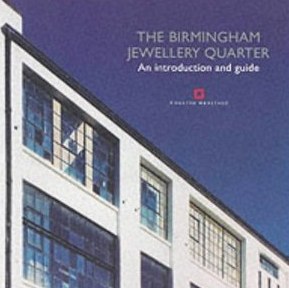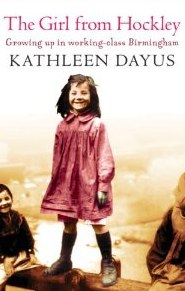Books about Birmingham’s Heritage and History: The Jewellery Quarter
Last month I listed in two posts the 10 most popular books bought by our supporters (if you buy through any of our Amazon links ( http://amzn.to/birminghamconserv ) on this site we get 5% of what you spend but you pay the normal price – so you can help us by shopping for the things you want).
Here’s a list of books that might interest anyone with a passion for Birmingham’s heritage – books about the wonderful Jewellery Quarter. Again but through any of the links below and we benefit. This list on no particular order:
 The Birmingham Jewellery Quarter: An Architectural Survey of the Manufactories. Incredibly comprehensive English Heritage Survey of the wonderful buildings of the Quarter – can be quite hard to get hold of. “Following on from the publication in 2000 of a short history and guide, this large hardback volume explores in much more detail the unique historical environment of the Birmingham Jewellery Quarter. This area of Birmingham was developed in the early 19th century with many purpose-built structures designed to house the jewellery and metal-working industry and its workers. This architectural history of the urban development of the quarter derives from a three-year survey carried out by the RCHME, and includes chapters on the origins and development of the industry, the processes involved, the development of workshops and factories, the buildings, and the operation of the factories, all set into the wider regional and national context of the Industrial Revolution. The final chapter looks at the area today and a gazetteer of 141 important buildings in the area rounds off this great study. Foreword by HRH The Prince of Wales. Summaries in French, Italian and German.”
The Birmingham Jewellery Quarter: An Architectural Survey of the Manufactories. Incredibly comprehensive English Heritage Survey of the wonderful buildings of the Quarter – can be quite hard to get hold of. “Following on from the publication in 2000 of a short history and guide, this large hardback volume explores in much more detail the unique historical environment of the Birmingham Jewellery Quarter. This area of Birmingham was developed in the early 19th century with many purpose-built structures designed to house the jewellery and metal-working industry and its workers. This architectural history of the urban development of the quarter derives from a three-year survey carried out by the RCHME, and includes chapters on the origins and development of the industry, the processes involved, the development of workshops and factories, the buildings, and the operation of the factories, all set into the wider regional and national context of the Industrial Revolution. The final chapter looks at the area today and a gazetteer of 141 important buildings in the area rounds off this great study. Foreword by HRH The Prince of Wales. Summaries in French, Italian and German.”
 The Birmingham Jewellery Quarter: An Introduction and Guide: A briefer (and cheaper) version of above. The Birmingham Jewellery Quarter contains the best and most extensive surviving group of Victorian and 20th-century buildings devoted to the manufacture of jewellery in Europe. The Quarter is still a vibrant manufacturing community, with people often still working from original premises and in many cases using original machinery and tools. This booklet distils the findings of an extensive architectural survey carried out in the Birmingham Jewellery Quarter. The first section explains the evolution of the Quarter and acts as an introduction to its characteristic buildings, the people who work there, and their products. The second section provides a walking tour of the Quarter, highlighting some of the most significant buildings, which readers can use to explore the area.
The Birmingham Jewellery Quarter: An Introduction and Guide: A briefer (and cheaper) version of above. The Birmingham Jewellery Quarter contains the best and most extensive surviving group of Victorian and 20th-century buildings devoted to the manufacture of jewellery in Europe. The Quarter is still a vibrant manufacturing community, with people often still working from original premises and in many cases using original machinery and tools. This booklet distils the findings of an extensive architectural survey carried out in the Birmingham Jewellery Quarter. The first section explains the evolution of the Quarter and acts as an introduction to its characteristic buildings, the people who work there, and their products. The second section provides a walking tour of the Quarter, highlighting some of the most significant buildings, which readers can use to explore the area.
Walks Through History: Birmingham The Newhall Estate and the growth of the Jewellery Quarter Kindle or Paperback : Each walk is circular, with clear concise directions supported by easy-to-use sketch maps, illustrated by a host of photographs. Each walk covers a specific period in the history of Birmingham, and goes past historic buildings and other sites from that period. The history of the sites seen is given in a highly readable and informative style that brings the past alive, and is so written that the book can be read as a history book alone, independent of the walking.
Together the twelve walks cover all the major themes in Birmingham’s history, and if read chronologically they lead the reader from Birmingham’s humble beginnings in Saxon times to its position as workshop of the world. Birmingham has a compact city centre, and six of the walks are around the centre. The other six are in the suburbs, each starting from a railway station within easy reach of the city centre.
 The Girl From Hockley: Growing up in working class Birmingham: Born into the industrial slums of Birmingham in 1903, Kathleen Dayus became a legend in her own time. She vividly recalls her Edwardian childhood and her life as a young munitions worker during the war, marriage and life below the poverty line in the 1920s. Early widowhood and the Depression forced her to relinquish her children to Dr Barnado’s homes until, eight long years later, she could afford a home for them again. Her autobiography is a testament to the indomitable spirit, humour and verve that characterised her life. Her extraordinary memory for the sights, sounds and smells of her youth, her marvellous sense of the comic and above all her spirited refusal to do anything but live life to the full, deservedly made her one of the most compelling storytellers of our time.
The Girl From Hockley: Growing up in working class Birmingham: Born into the industrial slums of Birmingham in 1903, Kathleen Dayus became a legend in her own time. She vividly recalls her Edwardian childhood and her life as a young munitions worker during the war, marriage and life below the poverty line in the 1920s. Early widowhood and the Depression forced her to relinquish her children to Dr Barnado’s homes until, eight long years later, she could afford a home for them again. Her autobiography is a testament to the indomitable spirit, humour and verve that characterised her life. Her extraordinary memory for the sights, sounds and smells of her youth, her marvellous sense of the comic and above all her spirited refusal to do anything but live life to the full, deservedly made her one of the most compelling storytellers of our time.
Birmingham’s Jewellery Quarter: An illustrated history and guide to Birmingham’s jewellery quarter together with a chapter on the Birmingham Mint.


